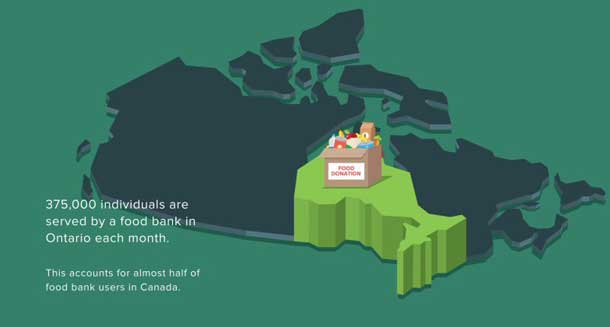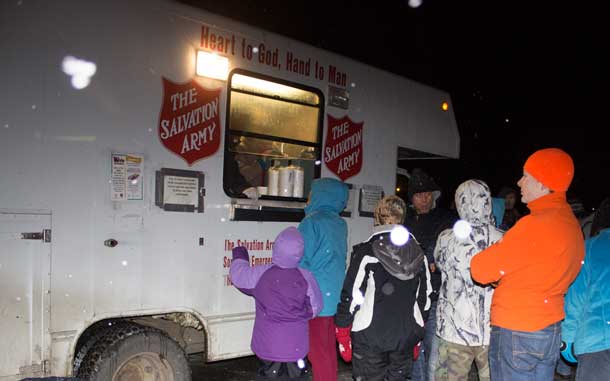 375,000 Ontarians served by a Food Bank
375,000 Ontarians served by a Food Bank
THUNDER BAY – Ontario Food Bank demanding is growing by up to 18% annually One of the growing industries in Thunder Bay and across Ontario is the Food Bank. It is something most people likely doubt is happening, but it is also one of the strongest economic indicators for Ontario. “Forty-five per cent of all people who use food banks in Canada live in Ontario, and children are by far the largest group of those who rely on food banks each month,” said Bill Laidlaw, Executive Director, Ontario Association of Food Banks (OAFB). “As a province, it is important to recognize that our neighbours, co-workers and children’s friends could very well be facing hunger or need support with other vital social services.”
Ontario stands in sharp contrast to Saskatchewan. In the prairie province of Saskatchewan has seen a 8.8 per cent drop in the amount of people seeking assistance.
The report is finding that many Ontario families are using food banks for the first time.

Last night in Thunder Bay the CP Holiday Train saw $13,000 and 1,100 kilograms of food donated to the local food bank. Demand is growing in Thunder Bay and it is to a point where targets for donations, and the efforts to help are being scaled back because demand is exceeding the ability of the Food Bank and related groups to supply enough food to those who need it.
Food Bank Growth Up to 18% Annually
The OAFB 2013 Hunger Report, released today, reveals that 375,000 Ontarians rely on food banks each month. The comprehensive annual report also sheds light on some surprising statistics about who uses food banks and how those users are being helped by the wide range of community services offered by community food banks across the province.
The Hunger Report finds that one third of the 375,000 Ontarians served by a food bank and their hunger-relief services every month are children. The 2013 report also reveals that one of the fastest growing populations of food bank users are post-secondary students and recent graduates, especially in rural areas. There is not one college or university campus in Ontario that does not have a food bank or some sort of hunger-relief program onsite.
Overall, food bank use has grown by as much as 18 per cent since 2007, largely due to a slow recovery from the economic recession, rising food prices, unemployment, and affordable housing shortages. These factors, alongside a number of emergency situations, such as the flooding in Thunder Bay and Minden, plant closures, and the Elliot Lake Mall collapse, have resulted in an increase in hunger.
“As a province with so much, there is no reason that any child should have to go to bed hungry,” said Laidlaw. “To meet these growing needs, food banks are now having to do so much more than provide emergency support. They are becoming hubs for social innovation, health and child care support, learning and training opportunities, and community development that stretch far beyond the traditional idea of a food bank.”
The OAFB is calling all Ontarians to support their local food bank and help spread the word about the face of hunger. Visit OntarioHunger.com for an infographic explaining this year’s findings and how to donate to the cause.
ONTARIO ASSOCIATION OF FOOD BANKS 2013 HUNGER REPORT
Highlights and Rising Trends
- More than 375,000 Ontarians to turn to food banks every month. That accounts for 2.8 per cent of the province’s population, making Ontario the most intensive user of food bank services in Canada.
- 45 per cent of all people who use food banks in Canada live in Ontario.
- This past year, 35 per cent of those served by food banks in Ontario were children under 18 years old.
- One of the fastest growing groups of food bank users is post-secondary students at 3.7 per cent. This rising trend is seen particularly in rural communities (up from 0.2 per cent to 1.2 per cent in one year).
The Changing Face of Hunger
- 16,294 households accessed food banks for the first time in their lives in March 2013.
- Only 0.4 per cent of those accessing food banks are homeless.
- 65.2 per cent of food bank users live in rental accommodations and 24.3 per cent are social housing tenants, while 5.1 per cent are homeowners.
- One quarter (25.6 per cent) of food bank users are single parent families.
- Two parent families account for another 20.5 per cent of those served.
- 10.3 per cent of those served are couples with no children.
- Another rising group of food bank users is senior citizens over the age of 65, comprising 3.9 per cent of those who visit food banks.
- 45 per cent of food bank users are woman over the age of 18.












